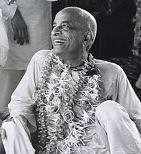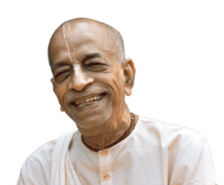

Sri Ramanuja Avirbhava Tithi – Monday, March 29, 2018. [Mayapura,west Bengal. Bharat
(above). the body of Ramanuja in Sri Rangam .(right) Ramanuja agreed to argue single handed.the king arranged a huge dias and open ground for 12000 jains.Ramanuja centrally seated over the dias should answer all queries. Ramanuja manifested as Adi Sesha with 1000 hoods and successfully addressed all jain acharyas and satisfied their questions.Srila Prabhupada cites and glorifies Ramanujacarya.compiled by Yasoda nandana dasa
The statements of Śrīmad-Bhāgavatam are accepted by great ācāryas like Śrīdhara Svāmī, RāmānujācāryaIt is indicated herein that the residents of Maharloka, where the purified living entities or demigods possess a duration of life calculated to be 4,300,000,000 solar years, have airships by which they reach Satyaloka, the topmost planet of the universe. In other words, the Śrīmad-Bhāgavatam gives us many clues about other planets far, far away from us which modern planes and spacecraft cannot reach, even by imaginary speeds. The statements of Śrīmad-Bhāgavatam are accepted by great ācāryas like Śrīdhara Svāmī, Rāmānujācārya and Vallabhācārya. Lord Śrī Caitanya Mahāprabhu specifically accepts Śrīmad-Bhāgavatam as the spotless Vedic authority, and as such no sane man can ignore the statements of Śrīmad-Bhāgavatam when it is spoken by the self-realized soul Śrīla Śukadeva Gosvāmī, who follows in the footsteps of his great father, Śrīla Vyāsadeva, the compiler of all Vedic literatures. In the creation of the Lord there are many wonderful things we can see with our own eyes every day and night, but we are unable to reach them equipped by modern materialistic science. We should not, therefore, depend on the fragmentary authority of materialistic science for knowing things beyond the range of scientific purview. For a common man, both modern science and Vedic wisdom are simply to be accepted because none of the statements either of modern science or of Vedic literature can be verified by him. The alternative for a common man is to believe either of them or both of them. The Vedic way of understanding, however, is more authentic because it has been accepted by the ācāryas, who are not only faithful and learned men, but are also liberated souls without any of the flaws of conditioned souls. The modern scientists, however, are conditioned souls liable to so many errors and mistakes; therefore the safe side is to accept the authentic version of Vedic literatures, like Śrīmad-Bhāgavatam, which is accepted unanimously by the great ācāryas. Link to this page: https://prabhupadabooks.com/sb/2/2/26In this verse the word tīrtha–pādīya indicates devotees of Lord Viṣṇu, or Vaiṣṇavas. As far as brāhmaṇas are concerned, in the previous verse the mode of reception has been already described. Now, in this verse, special stress is being given to the Vaiṣṇavas. Generally, the sannyāsīs, or those in the renounced order of life, take trouble to enlighten the householders. There are ekadaṇḍī sannyāsīs and tridaṇḍī sannyāsīs. The ekadaṇḍī sannyāsīs are generally followers of Śaṅkarācārya and are known as Māyāvādī sannyāsīs, whereas the tridaṇḍī sannyāsīs are followers of Vaiṣṇava ācāryas—Rāmānujācārya, Madhvācārya and so on—and they take trouble to enlighten the householders. Ekadaṇḍī sannyāsīs can be situated on the platform of pure Brahman because they are aware that the spirit soul is different from the body, but they are mainly impersonalists. The Vaiṣṇavas know that the Absolute Truth is the Supreme Person and that the Brahman effulgence is based on the Supreme Personality of Godhead, as confirmed in the Bhagavad-gītā (14.27): brahmaṇo hi pratiṣṭhāham. The conclusion is that tīrtha–pādīya refers to Vaiṣṇavas. In the Bhāgavatam (1.13.10) there is also another reference: tīrthī–kurvanti tīrthāni. Wherever he goes, a Vaiṣṇava immediately makes that place a tīrtha, a place of pilgrimage. Link to this page: https://prabhupadabooks.com/sb/4/22/11Ramanuja came from Dravida desaThe specific mention of Draviḍa–deśa refers to the five Draviḍa-deśas in South India. All are very strong in rendering the preliminary devotional processes (śravaṇaṁ kīrtanam). Some great ācāryas, like Rāmānujācārya and Madhvācārya, also came from Draviḍa–deśa and became great preachers. They were all situated on the platform of sakhyam ātma–nivedanam. Link to this page: https://prabhupadabooks.com/sb/4/28/30Learned authorities in devotional life consequently advise that one not endeavor to increase the number of temples and maṭhas. Such activities can be undertaken only by devotees experienced in propagating the Kṛṣṇa consciousness movement. All the ācāryas in South India, especially Śrī Rāmānujācārya, constructed many big temples, and in North India all the Gosvāmīs of Vṛndāvana constructed large temples. Śrīla Bhaktisiddhānta Sarasvatī Ṭhākura also constructed large centers, known as Gauḍīya Maṭhas. Therefore, temple construction is not bad, provided proper care is taken for the propagation of Kṛṣṇa consciousness. Even if such endeavors are considered greedy, the greed is to satisfy Kṛṣṇa, and therefore these are spiritual activities.ink to this page: https://prabhupadabooks.com/sb/7/15/21”Rāmānujācārya sometimes accepts Baladeva as a śaktyāveśa-avatāra, but Śrīla Jīva Gosvāmī has explained that Baladeva is an expansion of Kṛṣṇa and that a part of Baladeva is Saṅkarṣaṇa. Although Baladeva is identical with Saṅkarṣaṇa, He is the origin of Saṅkarṣaṇa. Therefore the word svarāṭ has been used to indicate that Baladeva always exists in His own independence. The word svarāṭ also indicates that Baladeva is beyond the material conception of existence. Māyā cannot attract Him, but because He is fully independent, He can appear by His spiritual potency wherever He likes. Māyā is fully under the control of Viṣṇu. Because the material potency and yogamāyā mingle in the Lord’s appearance, they are described as ekānaṁśā. Sometimes ekānaṁśā is interpreted to mean “without differentiation.” Saṅkarṣaṇa and Śeṣa-nāga are identical. As stated by Yamunādevī, “O Rāma, O great-armed master of the world, who have extended Yourself throughout the entire universe by one plenary expansion, it is not possible to understand You fully.” Therefore, ekāṁśā refers to Śeṣa-nāga. In other words, Baladeva, merely by His partial expansion, sustains the entire universe. Link to this page: https://prabhupadabooks.com/sb/10/1/69Yamunacarya as spiritual master of RamanujacaryaThis is a verse from the Stotra–ratna (12) of Yāmunācārya, the spiritual master of Rāmānujācārya. The authentic scriptures describe the transcendental activities, features, form and qualities of Kṛṣṇa, and Kṛṣṇa explains Himself in the Bhagavad-gītā, the most authentic scripture in the world. He is further explained in Śrīmad-Bhāgavatam, which is considered the explanation of the Vedānta–sūtra. Lord Kṛṣṇa is accepted as the Supreme Personality of Godhead by these authentic scriptures, not simply by vox populi. In the modern age a certain class of fools think that they can vote anyone into the position of God, as they can vote a man into the position of a political executive head. But the transcendental Supreme Personality of Godhead is perfectly described in the authentic scriptures. In the Bhagavad-gītā the Lord says that only fools deride Him, thinking that anyone can speak like Kṛṣṇa. Link to this page: https://prabhupadabooks.com/cc/adi/3/87Ramanuja explains the catur-vyuhavāsudeva-saṅkarṣaṇa-pradyumnāniruddhaSYNONYMSvāsudeva—the expansion named Vāsudeva; saṅkarṣaṇa—the expansion named Saṅkarṣaṇa; pradyumna—the expansion named Pradyumna; aniruddha—the expansion named Aniruddha; dvitīya catuḥ–vyūha—the second quadruple expansion; ei—this; turīya—transcendental; viśuddha—free from all material contamination.TRANSLATIONVāsudeva, Saṅkarṣaṇa, Pradyumna and Aniruddha constitute this second quadruple. They are purely transcendental.PURPORTŚrīpāda Śaṅkarācārya has misleadingly explained the quadruple form (catur–vyūha) in his interpretation of the forty-second aphorism of Chapter Two of the second khaṇḍa of the Vedānta–sūtra (utpatty-asambhavāt). In verses 41 through 47 of this chapter of Śrī Caitanya–caritāmṛta, Śrīla Kṛṣṇadāsa Kavirāja Gosvāmī answers Śrīpāda Śaṅkarācārya’s misleading objections to the personal feature of the Absolute Truth.The Supreme Personality of Godhead, the Absolute Truth, is not like a material object that can be known by experimental knowledge or sense perception. In the Nārada-pañcarātra this fact has been explained by Nārāyaṇa Himself to Lord Śiva. But Śaṅkarācārya, the incarnation of Śiva, under the order of Nārāyaṇa, his master, had to mislead the monists, who favo



